#(a crow and a blue jay are from the same family- similar birds with a few extra steps)
Explore tagged Tumblr posts
Note
in the tags you mentioned Tom’s wings were rotted until he killed Dianite, consider they turn into vulture wings after the fact? him being a zombie and having the wings of a scavenger
YOUR BRAIN
his wings turning into vulture wings because what is Tom if not someone who survives on the remnants of others? of their good will? their faith? the things they drop when Tom comes swinging, the glittering diamonds and mounds of iron he can raid from a person's unkept storage chest?
And of course, when a god dies and their power is posed to disperse, why wouldn't Tom naturally pick up that power? He wouldn't even have to think about it- hell, he probably doesn't even realize he was the one that sucked the power in. What is more vulture like that reaping the rewards of a dead god?
#lica im gonna think about this too hard#like waaaay too hard#like originally my thought ws that Tom had crow wings#bc ooo shiny kinda vibe#and also bc itd be funny bc crows and blue jays (what I hc tucker as) are in the same family#andit could be a nod to how similar tom and tucker are and how mianite and dianite are brothers despite everything#but now im imagining pre-death Tom has crow wings#post-revival theyre still crow wings but decayed and rotten and unable to fly#nd post killing dianite they become vulture wings#and its not only symbolic of his nature as a scavenger who lives off the remains of life#but also of how he is suddennly and definitively different from Tucker (and the rest)#in that while hed been a zombie he was basically just another human with some extra steps#(a crow and a blue jay are from the same family- similar birds with a few extra steps)#but in becoming a vulture he isnt like the rest anymore#he isnt just a bird that acts on its own to survive#he is a bird that has to feast on the dead to survive#mianite#mianite asks#mianite wing au
3 notes
·
View notes
Note
I love your Rook Tim Drake design!! It would be so cool to see Rook Tim Drake in the comics. If you haven't done this already, could you give an overview of the design, the events (if any) that trigger Tim fully moving on from Robin, and anything/everything else related?
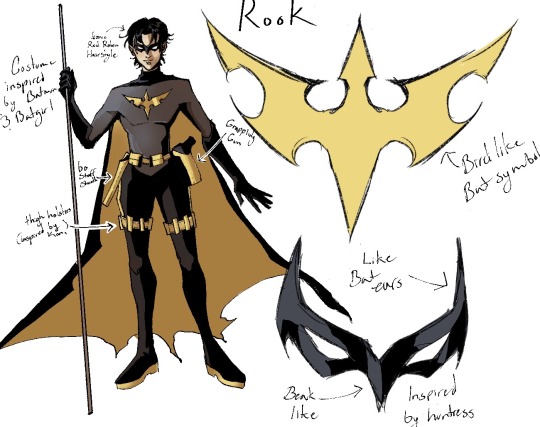
Hello, thank you! So this is kinda a sheet with my ideas behind the design. Some people mentioned its similarity to batgirl and that was on purpose. I wanted to use Tim’s companions and friends in the design. One thing I hated about a certain identity I refuse to acknowledge was the lack of cape. Tim needs a cape.
The name was something I came up when writing a fanfic a long time ago, it is now orphaned, much like most of the batfam. Rook has three meanings. First a Rook is a corvid, a type of bird considered extremely intelligent, the family consists of Rooks, Ravens, Crows, and Blue Jays. Second, a Rook is a chess piece. The castle piece, that moves in straight lines, it is a strategic and powerful piece. Third, it also describes a cheater/ swindler. I love Tim, but it’s very clear that he is quick thinking and not the most honorable in a fight. He’s only won against opponents like Lady Shiva by cheating.
Finally lore-wise how I’d imagine him leaving Robin would be a short series in which Tim gets caught in a Time Loop. No apparent cause, just suddenly stuck in a moment in time. As he’s trapped playing out the same day, he worries that the world is moving on without him, that time is still moving for everyone else but him. An obvious commentary on his state in dc right now. He realizes this fact, time has just been passing by without him changing and now with time stuck he finally makes a change. How it would end or who or what is behind the time loop, I don’t know, I’d have to think about it.
159 notes
·
View notes
Text
Anyone else give their Rookanis kids fun bird nicknames?
Personally, I just love the idea of all of their kids having a bird codename. Like, you've got "The Crow" with Lucanis and "The Rook" with Aylewin, thats already two black birds. Rook canonically loves puns man, why wouldn't they nickname their kids after birds?
So my six kids (so far, really debating if they should have more or just get some fucking cats) each have a bird nickname because I think its funny. Like Villa Dellamorte being referred to as The Nest or The Aviary.
Unfortunately, there are not that many corvids, so they don't all get to be a part of that family of birds. But they all are black birds!
So! The nicknames (and why they have that name) are under the cut. That way people who don't care can scroll faster.
So! We've got the eldest; Lace. Her nickname is The Songbird/The Blackbird, depending on who you ask. Friends and allies call her the Songbird. She's a mage, a bard, and she also is most prone to find the least violent way out of a situation. That being said, like her avian counterpart, she is extremely persuasive. Blackbirds, specifically the Eurasian Blackbird, have very melodic songs; and Lace has a very melodic tone of voice. She's good at getting people to listen, which is part of why she's so good at negotiations and crow politics.
Second up is Emily. She's nicknamed The Raven. She's a rouge, and usually blends into the background. She attends basically every single event, but no one recognizes her unless she wants them to. This is similar to the common raven, which i'm sure most people confuse with Crows, jackdaws, or Rooks (for non-us folks, apparently the us doesn't have rooks). Most folks, in my experience but I do know one bird expert who does know the difference at a glance, see a black bird and go: "oh hey, a crow!" This ties back to her specially being espionage.
Numbers 3 and 4 are twins, and they have the same nickname. A pair of rouges, Varric & Davrin, the first boys in the family, are both known as The Starlings. These two are NEVER seen without the other. Varric is the more friendly and sociable of the two, while Davrin is much more hostile at a glance. Their bird counter part is kind of similar: sociable little birds who form packs (Usually you see at least two or three, in my experience you rarely see a single one of them) but also are an invasive and mean species. These fuckers steal food from other birds (and elderly dogs who don't give a shit anymore) but they are also incredibly smart. Tieing back with the Twins, both are good at what they do. Varric specializes in distractions and misdirection, using his ability to read people and his training from his Uncle Illario to really know how to play people. Davrin, on the otherhand, uses his smarts in much more deadly ways. He's a star pupil of Viago, and is the number one poisoner in House Dellamorte.
Number 5, Bella, is nicknamed The Jay. Shes the oddball, the outlier. This isn't because she's mage. In a family raised for generations to kill and kill effectively; she's a healer. While Lace is a pacifist until she has to react, Bella will not fight back. She can handle blood and gore when its related to healing/helping others. When it comes to assassination? No thanks. In the bird world, Jays are an oddball. Most birds in the corvus family are solid black, or at least most of their body is black/they have large black patches. Jays are not like that. They are often colorful! Jays, specifically the Blue Jay, are also incredibly smart and know how to mimic human voices and hawk sounds. In the case of Bella, her incredible knowledge of the body and the science involved with it aids her healing, but she is still related to assassins and knows how to help with the dangers of that job.
Finally, we're on number 6! Elli, a warrior and explosives expert, gets the nickname of The Grackle. No one is quite sure where he gets his temper, but at the very least, he knows how to calm it. He is very much a: Act first, question later type of person. He's loud and doesn't care. Grackles are among my favorite birds because these little fuckers are LOUD. And they have the best fucking calls. I love them. They also just so happen to be considered a pest in a lot of places because of how obnoxious and messy they are. Plus, they tend to bully other birds. This stupid, aggressive, and messy sort of attitude is similar to the youngest (for now) Dellamorte. He definitely gets in the most trouble, and they have to work out specific cases for him because he does NOT do subtle. His explosives expertise is used by most houses. Guarantee the Crows wish he was alive at the time of Veilguard because the Antaam have NOTHING on this idiot who likes to make shit go boom.
Yes, all of their kids are named after someone else. Most of them use nicknames (not the bird ones) to differentiate. Lace, Davrin, Bella and Varric are all pretty obvious. But Emily and Elli are named after Emmrich and my Inquisitor Ellia.
I've got SO much lore about these fucking kids. This is literally just the tip of the iceburg. Thanks hyperfixations!
#rookanis#dragon age#dragon age the veilguard#dragon age veilguard#dragonage#dragon age: the veilguard#lucanis dellamorte#lucanis x rook#rook x lucanis#rook aldwir#rookanis kids#dragon age ocs#OC: Aylewin Aldwir#Aylewin Aldwir
26 notes
·
View notes
Note
hi artichoke i hope you’re having a fun holiday season! I kinda want to hear more about ace avian but don’t want to make you grind so you are free to infodump or sketchdump whatever you want here that wouldn’t really fit in other posts just for fun.
um getting self conscious right now but I know pretty much everyone likes asks so gonna send this right now :D happy holidays!
hi rosie !! my holidays are so chill i am having a blast <33 hope you're having a good month too ! i am glad you asked! i am going to use this opportunity to share all the bird choices that were requested that i never ended up drawing!:
Athena Cykes: Golden Masked Owl - @/modpoppy helped with his one. Owl is so perfect to me because Athena (goddess of wisdom who has an association with owls) (also just wisdom being associated with owls). Owls have exceptional hearing! They also have ears that are non symmetrical, allowing them to pinpoint where sounds are coming from more accurately, which to me matches Athena's ability to read the emotion of a voice.
Gumshoe: Rock Dove (Pigeon) - these birds are historically trained, good sense of direction, and ones that live in cities are constantly eating crumbs (skull emoji x3)
Redd White: Peacock - I got a few recommendations for a bald eagle, which I totally see the vision for ! But to me, he is a peacock for sure. Pompous as all get out, flashy, show off.
Juniper Woods: Warbling White Eye - pretty green bird, often carries connotations of spring. another idea for her wasa mourning dove. this one is kinda just vibes
Robin Newman: I'm not super decided but maybe a type of kingfisher?
Hugh O'Conner: He gives me such raven vibes but, spoiler alert, Kay is 100000% a raven. If I'm trying not to have duplicates, i'm less sure. A crane hawk, maybe?
Kay Faraday: Raven - In Shinto mythology, I think that Yatagarasu is depicted as a three-legged crow? However, I'm pretty sure in the aa games Kay calls it a 3-legged raven. But if I'm wrong about this please feel free to correct me! Either way it is her x3
Spark Brushel: I never decided for Spark. I was thinking maybe a swallow or a seagull? Swallow because fast, energetic, fits the reporter who always is first to a story vibe. Seagull fits that latter idea, but also has seagull charm x333
Vera Misham: I am not sure of this one either. I know I want a small bird, and one where the males are brighter than the females, like how her dad was the face of their operation, like a songbird, maybe a finch or a bunting. Not sure of specifics.
Okay and then TGAA characters !! I ended up not yet finishing the second game :pensive: so some are missing
Ryuunosuke: Black-Billed Magpie - I also want to switch Phoenix to this one for consistency's sake. This is a lot of the same reasoning as Phoenix being a blue jay originally, so check back to that post if you want more reasoning. (jays and magpies are closely related). Coloration was a big factor in this decision, but also i like the myth that a lone magpie will bring badluck and how that works with the naruhodo family.
Sholmes: a fewwww ideas... though admittedly all vibes. I've racked my brain for him. A pheasant is one way to go. I think my favorite idea is a chicken (golden comet chicken). This is for similar reasons as @\modpoppy gave for buff orpington chicken Bobby Fulbright (that being friendly; golden retriever of birds). If not chicken.. sholmes still feels like a game bird to me..... solely vibes....
Stongheart: golden pheasant LMAOO i don't know why this guy got a bird in my mind before kazuma or susato or iris or etc,,, but he did. good for him. I just think its fits.
That is all i have! once again sorry from myself 2 months ago for not finishing these requests x33 i hope everyone who sent something in sees this text post lol
#okramblings#ace avian#ask#ty for the ask!#i hope this scratches your ace avian itch#thank you for sending it even tho you felt self conscious :33 it did make me happy to receive :D
13 notes
·
View notes
Note
Just checking in that you are taking care of yourself and getting plenty of rest. You deserve the moons of Jupiter and the rings of Saturn.
during 2020 we started putting out big trays of birdseed on our balcony. and tuna and fruit for our local crows. we ended up becoming a weird community space. we get blue jays, cardinals, chickadees, crows, squirrels - all at the same time, eating together. once, a clearly domesticated parakeet that had escaped someone’s house and made a new home with a flock of sparrows. the cardinals and corvids eventually brought their babies (baby birds who are being made to eat their own food for the first time are LOUD.) since then we’ve had three generations of crows who are comfortable enough to let me sit with them on the balcony while they eat & i drink my tea. our particular flock usually comes back from march to august. everytime, i am so excited to see my little family. i can’t tell you the feeling i get when they come back for the season.
but it’s similar to how i feel when i get a message or a comment from you
you are so sweet and thoughtful. thank you for checking in. i know it doesn’t look like it but i am easing up! blackmail material is the only thing ill be working on this weekend. maybe i’ll do another kinktober prompt on the 25th. but i promise i am being good. i went to bed at a semi-reasonable hour last night and everything! and im just putting less pressure on myself which honestly makes the most difference
thank you, my dear friend, for being so good to me ♡
#rfh asks#you are such a fuckin sweetheart#a flawless freshwater pearl#a nacreous shell#an iridescent nebula#and i love you
8 notes
·
View notes
Text
Cyanocitta cristata
On the edges of the American Northeastern deciduous forests there is squawking, “Jay! Jay!” This boisterous call is one Midwesterners know all too well during a lively summer afternoon. Cyanocitta cristata, otherwise known as the blue jay, calmly soars the sky and elevates itself with graceful little bursting flutters. The sunlight dances on its elegant blue wings while the white underbelly and U-shaped collar of black wrapping behind its crest, compliments the striking blue plumages adorning this passerine bird. Although passerines are classified as songbirds, the blue jay takes after its distant relatives the crow and raven. Belonging to the Corvidae family, these birds learn to mimic by listening to their environment and copying sounds like human speech or impersonating a hawk, but most certainly not singing.
Humans and birds share a symbiotic relationship rooted in our love for their beauty, songs, and aesthetic presence in our gardens. Homes devote entire landscapes for aviating visitors with shepherds hooks bursting full of seeds and grains or adorably crafted miniature wooden houses inviting them to stay. Even humans befriend crows and ravens with repetitive food offerings and shiny gifts. Unfortunately, blue jays fell out of our favor.
The round blue bird’s reputation is infamous and notorious among the suburbs. Most people view them as pesky and violent, attributing this to a common belief that jays devour eggs and fledglings, however a study looking at 250 stomachs found only six to contain remnants of shells and hatchlings. Meanwhile, another study saw blue jays being dominated by red-headed woodpeckers, cardinals, and gray squirrels at bird feeders.
By focusing on the negative, opportunities to acknowledge the positives are missed. Blue jays demonstrate high functioning intelligence and form complex social relationships with their flocks. Protecting the nest is considerable business since building it was a labor of love by both the male and female. For blue jays, love is a serious affair involving more than the typical fervor because romancing the one is not as simple as dating. This courtship involves an aerial duet chase that transcends into a dance meant to impress the nimblest of feather and flight. If the suitor succeeds in swooning the lady in question, then she will allow him the intimacy of feeding her and they become lifelong mates.
Sometimes lifelong is not always the case. A recent study found a female blue jay bonding with a different male when her mate disappeared for over three weeks. When the mate returned, to his dismay, his love was taken from him. After an aggressive standoff with her new man, it seemed like he had lost the love of his life, but with several offerings of food and twigs, possibly reminding her of their thriving brood last season, she took him back. A similar quarrel between male jays involves a strapping young man and an established older gentleman. After losing his mate, the youthful jay set his eyes on the older jay’s partner. Noticing the home wrecker, the older jay never left his lady’s side and continuously offered her gifts until the surmounting pressure forces him to move his territory away from the young prying eyes. The intricate social lives of blue jays reveal there’s more to these passerines than assumed.
The blue jay is a familiar beautiful sight in the Midwest with an unfairly decided regard. Research evidence concludes that the higher society of birds handle their pecking orders differently than humans rumored. Popular opinion labels blue jays as aggressive songbirds but specimen stomach contents found less than one percent of eggs or hatchlings, and that blue jays are more likely to be chased away from a bird feeder than do the chasing. The dramatic social lives of corvids entail romantic lifelong endeavors, or so we thought. On the contrary, blue jays go through the same ups and downs of typical marriage and scandal that seem inherent of complex social structures. So, the next time one hears the squawking, “Jay, Jay,” think kindly of the blue jay.
1 note
·
View note
Photo

Bio of my AU:
“ Silver Pigtall ”
Relationships:
Red Cardinal (They don't get along, allied)
Chuck Canary (allied, Illegal adoptive sibling)
Bomb Crow (friend)
Jay, Jake and Jim Blue (Best friends)
Matilda Whitezen (Maternal Figure)
Hal TuGreen (Legal guardian, best friend and father figure)
Bubbles Oragenblack (Best friend and interest romance)
Terence Cardinal (Friend)
Stella Galah (Friend)
Poppy Ninfacatu (Friend)
Dahlia Owler (They don't get along)
Willow Lightblue (Friend)
Luca Celeste (Great Friend)
Gale ???? (enemy)
Ruby Plumeroja (acquaintance)
The Pigs (enemies and adoptive family)
Leonard BigFatGreen (Enemy, adopted relative)
Ross Pigtall (Father / Mother Adoptive)
Mighty Eagle or Ethan (Mentor)
Frosh (acquaintance)
She's the newest of the flock, but she's currently with Hal and Bubbles.
She was found by pigs since she was an egg and she came out of the cascade in the castle kitchen. (If what you read...in my AU, human versions of birds are born from eggs...Perturbing). And from that moment on she learns the customs of her family and stays with Ross, Leonard's first assistant.
At adolescence (12 years old), the pigs send her on her mission on deck against the birds; she passes herself off as a survivor of the pigs to win the bird island, but Red doesn't trust her because of her attitude similar to her enemies. After a while, she gains the trust of almost everyone, except Red, in a moment, she publicly humiliates him by telling him that he is a poor orphan and he calls her in response: And you...phenomenon of horrible teeth; she felt shattered and ran away, almost all the people turned against Red, except her team although they still don't like that attitude. In a place far from the village, Silver wiping her tears, signals the pigs for attack as revenge on Red.
When the massive attack began, Silver realized the real purpose of her family, repented and helped the remaining members of the flock and defeated the pigs (there's an important part I won't count, because it's a spoiler). Silver decides to cut her ties with the pigs definitively and wants to start again, Hal offers to adopt her to travel and learn new things along with Bubbles, as they are the only ones, along with The Blues, Luca, Chuck, Bomb, Matilda and Terence who forgave her, she happily accepts.
Now she's with Hal and Bubbles traveling to different places, while even Red has a grudge against her.
(Something apart, I WILL NOT USE THE HISTORY OF ABM2...you already know the reason and it is not necessary to repeat it)
Her power is the same as the game (Angry Birds 2)
Her personality is just like the game and some external data, in other words, she has the same attitude as pigs, but she wants to become someone unique (not a bird or a pig).
(Also...I WILL NOT HAVE THE PERSONALITY OF THE MOVIE...seriously, it made me angry like never that "Silver Mary Sue")
Separate note: in my AU, she is 12 years old and...Red is 23...so...nope)
@loverofthebirbs
#angry birds#Angry Birds Movie#The Angry Birds Movie#angry birds movie 2#angry birds 2#The Angry Birds Movie 2#silver#my art#artists on tumblr#au
38 notes
·
View notes
Text
Experiment!Billy AU
I see people talking about their wing billy AUs and realize ive never talked about mine o:
This au is post-s2, where Billy is kidnapped by the labs and its covered up as he ran away for california. The rumor is planted and small town gossip does the rest. So they have a new project going at the labs: Project Avian- the hybridization of various species with bird genetics. Billy is to be a human subject.
He's one of the first three successful human experiments in the project.
Instead if giving him white angel wings or black raven wings or even owl wings, I decided I was going to go for something in my opinion was the perfect fit.

The Bluejay
Why the Bluejay, you ask? For multiple reasons, and starting with the most obvious one- look at those colors. Blue plumage to bring out his eyes, and similar in hue to the Camaro. It’s aesthetic, really.
Now to get into the rest of it.
They’re Corvids, in the same family as crows and magpies. They’re incredibly smart, and have been observed in captivity to create and use tools to their advantage. Given that most- myself included- headcanon Billy as intelligent and an A+ student, a corvid is a good choice of bird
If you ask most people what their thoughts on bluejays are, they’ll say they hate them. They’re very aggressive birds, known to attack smaller birds and have a reputation for being bullies amidst fowl. They’re also known to mob hawks, owls, cats, and even people.
They’re also loud, and employ a wide range of vocalizations. From soft trills to their iconic jay! jay! sounds, you can expect just about anything from them. They’re also excellent at mimicking hawks, cats, crows, and even cell phone ringtones. Someone as loud and talkative as Billy would need to be a vocal bird
They mate for life, so if we’re going down the harringrove route... *eyes emoji*
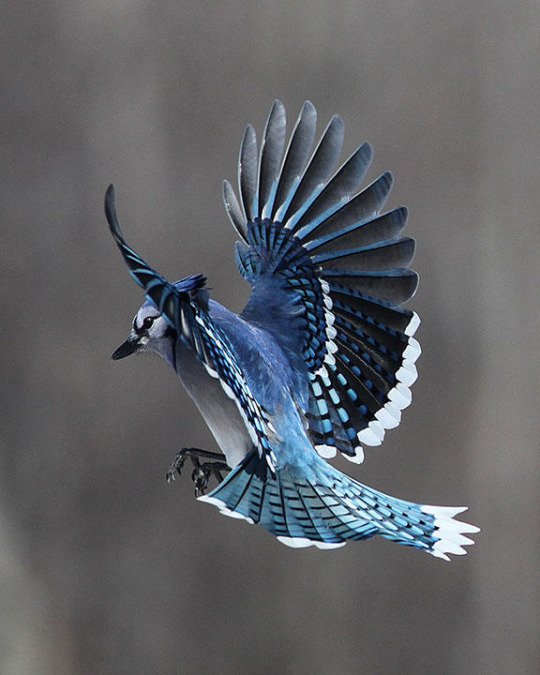
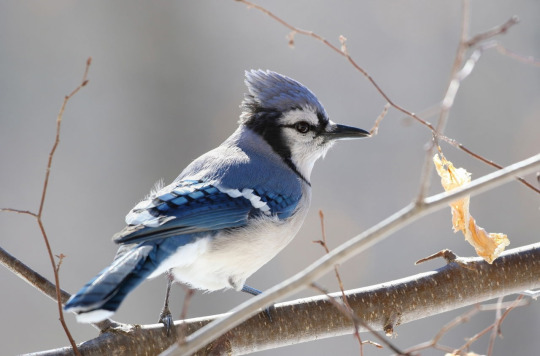
#billy hargrove#harringrove#bluejay!billy#experiment!billy#if anyone wants to scream with me about how cool bluejays are then feel free to dm me
66 notes
·
View notes
Text
Something About A Bird: Corvid Iridescence
One of the things we humans appreciate so much about birds is their colors. Of the animals we most commonly encounter, they’re the most visually interesting. They’re bigger than insects, they’re not confined to water like fish, and they’re more colorful than mammals. And we seem to especially appreciate the bright and shiny, which is a preference we share with certain wearers of iridescence: the crows, jays, and magpies, or corvids.
Iridescence is the term for when something appears to change color as the angle changes. Usually it’s caused by differences in the layers of material that affect the bending of light. It’s in oil slicks and soap bubbles, and it’s also in bird feathers, where it’s a feature of tiny microstructures in the feathers that work to bend the light in interesting ways.

The most prominent case of iridescence in corvids are probably the magpies of the Pica genus, all of which seem to favor similar black and white aesthetics like the pictured Eurasian magpie. But the black isn’t truly black: when it catches the light just right, we see a metallic sheen that shifts from yellowish-green through blue to violet overtop the black tones. The tailfeathers seem to have a sharp separation between yellow-green and blue-violet. The wings tend to stand out in a lustrous blue. And all of this is due to those tiny little structures in the barbs of the feathers that work to bend light.
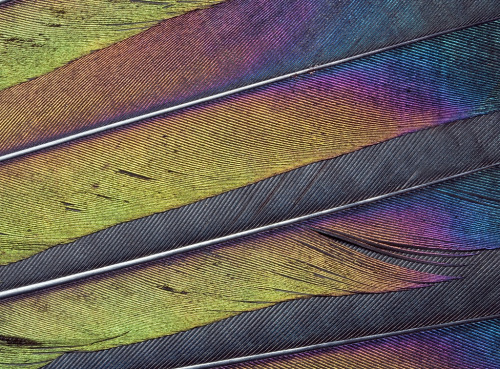
But just because magpies are the boldest doesn’t mean they have the monopoly on iridescence. Most crows and ravens have at least some amount of weak iridescence in their black feathers. Mostly it’s in blues to violets, and it takes much more exacting lighting conditions and angles to appreciate. It’s most obvious in the wings and scapulars (shoulder feathers).
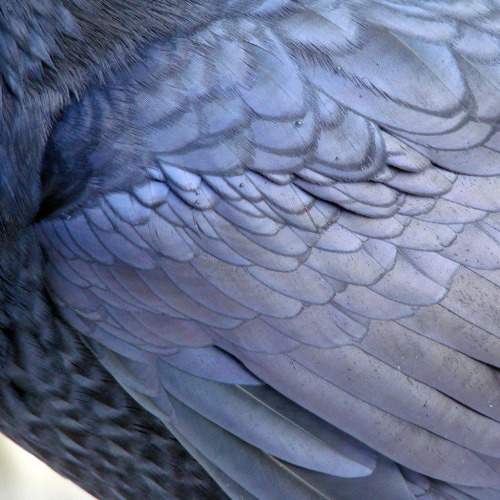
Ravens and crows tend to be described as having “glossy” feathers, and that’s also an effect of the iridescence, amplifying the play of light on the feathers and making them appear almost metallic.

The basis for iridescence in corvid feathers seems to be in the bright blues worn by some jays. These colors are not technically iridescent, since they stay blue, but the cause of the blues is the same: microstructures in the barbs of the feathers that change the way that light bounces through them. It seems this kind of eye-catching blue was the origin of what became iridescence in corvids, according to at least one study on the topic.
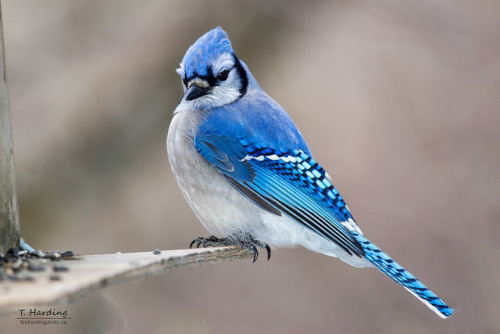
Unsurprisingly, one such blue-colored jay is the blue jay, but that name really understates all the blue that’s going on in its plumage. Once again it’s the wings and tail that have the most eye-catching coloration and patterning, with almost a checkerboard-like appearance on the folded secondary wingfeathers. I’d be remiss not to point out that fantastic blue crest, especially since crest feathers are so useful at expressing visual communication. Even the softer blues of the back of the neck and cheeks are from the microstructures in the feathers that are similar to what makes feathers iridescent.
Iridescence has developed multiple times in multiple branches of the avian family tree, going all the way back to non-avian ancestors like Microraptor. Fossils of its feathers show the same microstructures that make for glossy metallic green-blue-violet. The purpose of the iridescence in dinosaurs is conjecture, but in many birds, it’s the male that has the showiest feathers, including iridescent ones. Male peacocks, hummingbirds, grackles, and many other birds wear color-shifting rainbows, while the females are relatively drab in comparison, making the iridescence part of courtship and display.
However, almost all corvids are not sexually dimorphic: a male crow and a female crow are both the same glossy black. So courtship seems to be far less likely to be the reason for the sheen. Corvids are, however, very social birds, often living in extended families and flocking together. It seems more likely that the iridescence plays more of a social signalling role for them, or at least not the same kind of competitive courtship role. The result in our eyes is some stunning and understated iridescence that makes these shiny-loving birds shine themselves.
Photos reproduced here originally appeared in the following posts: Eurasian magpie - magpie tailfeathers - American crow - common raven - blue jay
218 notes
·
View notes
Photo

Like Humans and Apes, Ravens Can Plan for the Future
The birds were able to choose and hold onto a tool that could unlock an eventual reward
by Jason Daley
There’s no doubt that corvids—the family of birds that includes crows, ravens, jays and magpies—are smart. But as Ed Yong at The Atlantic reports , a new study on ravens shows just how intelligent the birds are. Researchers found they can actually delay gratification and plan for the future—a skill only previously documented great apes and in humans age four and older.
Lund University researcher Mathias Osvath raised five ravens for this study at his farm in Sweden. According to Yong, Osvath and his colleagues set up an experiment in which they trained the birds to open a puzzle box by dropping an oblong stone into a tube, which unlocked a box of tasty dog kibble. The researchers then moved the puzzle box out of the bird's sight. An hour later, they offered the birds a tray covered with enticing objects, including the stone that opens the puzzle box.
Though the birds had no knowledge of whether the kibble box would return or not, the ravens chose the box-unlocking stone from the tray in 86 percent of the tests. In a similar experiment, the birds exchanged a blue bottle cap for a treat. As Yong writes, "the cap had no intrinsic value and the birds" and they had no idea if the same researcher would return with food. But as with the case of the stone, in majority of the cases, the birds chose the tool that had a possibility of obtaining food in the future. They published their results in the journal Science...
(read more: Smithsonian Magazine)
photograph by BombTime | Wikimedia Commons
#raven#corvid#birds#birdwatching#animals#nature#animal intelligence#animal behavior#science#ornithology
150 notes
·
View notes